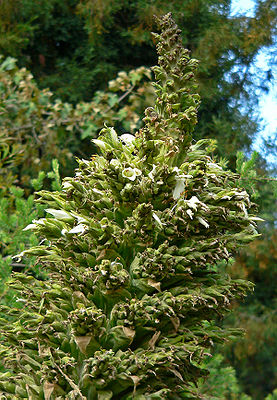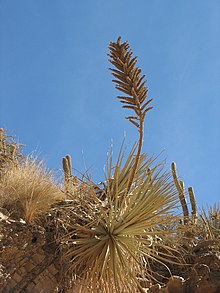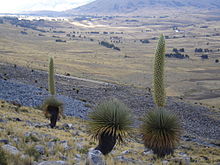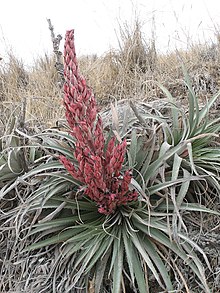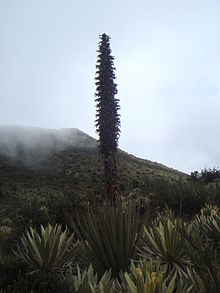
Puya alpestris, Ecological Botanical Garden, University of Bayreuth, December 8, 2019

Flower in detail with hairy sepals, greenish petals, stamens and style with stigma of Puya chilensis
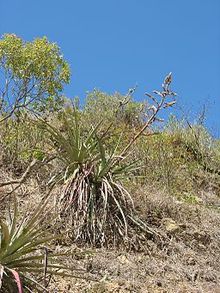
Habitus, leaves and inflorescence of Puya claudiae in the habitat

Habit and inflorescence with metal-blue flowers of Puya laxa

Habitus, leaves and inflorescence of Puya minima in the habitat
-
Puya adscendens L.B.Smith : It thrives at altitudes of around 2800 meters in the Peruvian Amazon department.
-
Puya aequatorialis André : It thrives on rocky slopes at altitudes of 2200 to 2400 meters in Ecuador in Imbabura, Azuay and Loja. In 2012 an albino form Puya aequatorialis f. albiflora (André) Gouda described.
-
Puya alata L.B.Sm. : It thrives on very dry, rocky soils at altitudes of about 1000 meters only in the Bolivian Potosi.
-
Puya alba L.B.Sm. : It thrives at altitudes of around 800 meters only in the southern Bolivian Department of Tarija .
-
Puya alpestris ( Poeppig ) Gay : Since 2013 there are two subspecies:
-
Puya alpestris (Poeppig) Gay subsp. alpestris (Syn .: Puya whytei Hooker. f. , Puya pumila Ravenna ): It thrives on dry slopes in central to southern Chile and Argentina .
-
Puya alpestris subsp. zoellneri (Mez) Zizka, JVSchneid. & Novoa : It thrives in stony, dry locations at altitudes from 0 to 2200 meters in northern and central Chile.
-
Puya alpicola L.B.Sm. : It thrives in the open, rocky Páramo at altitudes of 3600 to 3700 meters only in the Colombian Magdalena.
-
Puya angelensis E. Gross & Rauh : It thrives on steep rock faces at altitudes of around 3500 meters in Ecuador.
-
Puya angulonis L.B.Sm. : It thrives on rocky slopes at altitudes of 3500 to 4000 meters in the Peruvian departments of Cajamarca and La Libertad.
-
Puya angusta L.B.Sm. : It thrives on rocky slopes at altitudes of 3430 to 4000 meters in the Peruvian departments of Cajamarca and Ancash.
-
Puya antioquiensis LBSm. & RWRead : At altitudes of around 3340 meters in Colombia, it only thrives in Antioquia.
-
Puya araneosa L.B.Sm. : It thrives at altitudes of around 4000 meters in the Peruvian Lima department.
-
Puya argentea L.B.Sm. : It thrives at altitudes of around 3000 meters in the Peruvian department of Ancash.
-
Puya aristeguietae L.B.Sm. : It thrives in the paramo at altitudes of 2700 to 3200 meters in Venezuela in Trujillo and Merida.
-
Puya asplundii L.B.Sm. : It thrives terrestrially in shrub vegetation and in Paramo in Ecuador .
-
Puya assurgens L.B.Sm. : It thrives on rock outcrops at altitudes of around 2000 meters only in Jujuy, Argentina.
-
Puya atra L.B.Sm. : It thrives on stony, moist soils in the cloud forest at altitudes of 3000 to 3150 meters only in Cochabamba, Bolivia.
-
Puya barkleyana L.B.Sm. : It only thrives at altitudes of around 2800 meters in Santander, Colombia.
-
Puya bermejana Gomez, Slanis & Grau : It was first described in 2007 from the Bolivian Department of Tarija.
-
Puya berteroniana Mez (Syn .: Pitcairnia alpestris sensu LHBailey non (Poeppig) Gay , Puya coarctata sensu Philippi , Pitcairnia coerulea sensu Benth ex Baker. , Puya coerulea sensu Johow non Lindl. , Puya whytei sensu Gourlay ): It comes in the Chilean Coquimbo, Aconcagua, Valparaiso and Santiago.
-
Puya bicolor Mez : It thrives on rocks and rocky slopes at altitudes of 2580 to 2850 meters in Colombia in Norte de Santander, Boyaca and Cundinamarca.
-
Puya boliviensis Baker (Syn .: Puya copiapina Philippi ): Not much is known of this species. The type material wascollectedin 1836 by Charles Gaudichaud-Beaupré near Cobija , which at that time belonged to Bolivia (hence the specific epithet boliviensis ), so it comes from today's Chilean region II = Antofagasta; it should also occur in region III = Atacama.
-
Puya boopiensis R.Vásquez, Ibisch & R.Lara : It was first described in Die Bromelie , 2007, 2, pp. 86-93. So far it has only been found at altitudes of about 950 meters in the Bolivian department of La Paz .
-
Puya boyacana Cuatr. : This endemic thrives in the Paramo de Guantiva between Alto de Canutos and Campohermoso at altitudes of 3300 to 3400 meters only in Boyaca, Colombia.
-
Puya brachystachya (Baker) Mez : It thrives on open dry slopes at altitudes of around 2850 meters only in Magdalena, Colombia.
-
Puya brackeana Manzan. & W.Till : It was first described in 2005 from Ecuador. So far it has only been found in the Ecuadorian province of Azuay and thrives terrestrially on humid paramos at altitudes of around 3360 meters.
-
Puya bravoi Aráoz & A.Grau : It was first described from Argentina in 2008. So far, it has only been found in Salta, Argentina, at altitudes of around 3,100 meters and thrives terrestrially on rocky and grassy slopes above the tree line .
-
Puya brittoniana Baker : It is only known from the type material that was collected in 1886 near Sorata, Larecaja, at an altitude of about 3000 meters in La Paz, Bolivia.
-
Puya cajasensis Manzan. & W.Till : It was first described in 2005 from Ecuador. So far it has only been found in the Ecuadorian province of Azuay and thrives terrestrially on very humid paramos at altitudes of around 4010 meters.
-
Puya cardenasii L.B.Sm. : It thrives on rocky, grassy slopes at altitudes of 3800 to 3900 meters in Bolivia only in Cochabamba.
-
Puya cardonae L.B.Sm. : It thrives at altitudes of 3100 to 3300 meters in Venezuela only in Tachira.
-
Puya casmichensis L.B.Sm. : It only thrives at altitudes of around 1800 meters in La Libertad, Peru.
-
Puya castellanosii L.B.Sm. (Syn .: Puya fiebrigii sensu Castellanos non Mez ): It thrives at altitudes of 2800 to 3000 meters in dominant stands only in Salta, Argentina.
-
Puya cerrateana L.B.Sm. : It thrives in rocky locations at altitudes of 2000 to 3560 meters in the Peruvian Cajamarca and Ancash.
-
Puya chilensis Molina (Syn .: Pitcairnia chilensis Lodd. Cat. Ex Loudon , Pitcairnia coarctata Pers. , Pourretia coarctata Ruiz & Pav. , Puya coarctata (Ruiz & Pav.) Fisch. , Puya gigantea André , Puya gigantea (Phil.) Baker , Puya gigantea (Phil.) Baker ex Mez , Puya quillotana W. Weber , Puya suberosa Molina ): It thrives in dry, stony locations near the coast in Chile.
-
Puya claudiae Ibisch, R.Vasquez & E. Gross : It was first described in 1999 from Bolivia. So far, it has only been found near the southern border of the Amboro National Park in the Bolivian Department of Santa Cruz. It thrives at altitudes of around 2000 meters in disturbed locations in the bushes that replace a semi-humid mountain forest.
-
Puya clava-herculis Mez & Sodiro : It thrives in the Paramo at altitudes of 3350 to 4200 meters in the Colombian department of Nariño and Ecuadorian Imbabura and Azuay.
-
Puya cleefii L.B.Smith & RWRead : This endemic species thrives as a locally very common species in crevices on rock walls at altitudes of around 3700 meters only in the Colombian Boyaca. It is associated with Masdevallia spec. and Scaphosepalum spec. in the lower Paramo of the Paramo Concavo and the Sierra Nevada del Cocuy.
-
Puya cochabambensis R.Vásquez & Ibisch : It was first described from Bolivia in 2000. It thrives terrestrially on rocks at altitudes of 3200 to 3600 meters only in the Bolivian department of Cochabamba.
-
Puya coerulea Lindl. : There are four varieties in Chile:
-
Puya coerulea Lindl. var. coerulea (Syn .: Puya violacea sensu Walt.Watson ): Your area is limited to the Chilean coastal cordillera. It thrives in stony, semi-arid areas at altitudes of rarely 20 to usually 500 to 2000 meters.
-
Puya coerulea var. Intermedia (LBSm. & Looser) LBSm. & Looser (Syn .: Puya violacea var. Intermedia L.B.Sm. & Looser ): It thrives at altitudes of 400 to 700 meters in Colchagua and Aconcagua, Chile.
-
Puya coerulea var. Monteroana (LBSm. & Looser) LBSm. & Looser (Syn .: Puya violacea var. Monteroana L.B.Sm. & Looser ): It occurs only in the Chilean Colchagua.
-
Puya coerulea var. Violacea (Brongn.) LBSm. & Looser (Syn .: Puya glabrata Phil. Ex Baker , Puya paniculata Phil. , Puya rubricaulis Steud. , Puya violacea (Brongniart) Mez ): It thrives in dry, open, stony locations at altitudes of 400 to 700 meters in Chile.
-
Puya commixta L.B.Sm. : This endemic thrives at altitudes of 1800 to 2100 meters only in the Peruvian region of Puno .
-
Puya compacta L.B.Sm. : It thrives at altitudes of 2740 to 3290 meters in Ecuador only in Azuay.
-
Puya coriacea L.B.Sm. : This endemic thrives at an altitude of about 3640 meters only 40 km from Pullac at the transition of the Rio Chuagon valley, from the Rio Maranon to Buldibuyo, Huamachuco in the Peruvian region of La Libertad .
-
Puya cristata L.B.Sm. : This endemic thrives on slopes with dry grass at an altitude of about 3000 meters only in the Bolivian department of Cochabamba.
-
Puya cryptantha Cuatr. : This endemic thrives at altitudes of 3100 to 3200 meters only in the Paramo de Zipaquira between Zipaquira and Pacho in the Colombian Cundinamarca.
-
Puya ctenorhyncha L.B.Sm. : This endemic thrives on rocky slopes at an altitude of about 3500 meters only in Anilaya-Larec in the Bolivian department of La Paz.
-
Puya cuatrecasasii L.B.Sm. : This endemic thrives in the paramo at altitudes of 3400 to 3800 meters in Colombia in Tolima and Cauca.
-
Puya cuevae Manzan. & W.Till : It was first described in 2005 from Ecuador. It thrives terrestrially in humid paramos at altitudes of 3000 to 3400 meters in Ecuador only in Loja.
-
Puya cylindrica Mez : It thrives at altitudes of 2500 to 2600 meters only in the Peruvian region of Arequipa.
-
Puya dasylirioides Standley : It thrives in Sphagnum swamps in cloud forests at altitudes of 2100 to 3000 meters in Costa Rica only in San Jose.
-
Puya densiflora Harms : It thrives on rocks and on rocky slopes at altitudes of 2000 to 3000 meters in the Peruvian regions of Cuzco and Arequipa .
-
Puya depauperata L.B.Sm. : This endemic thrives at an altitude of about 2700 meters only in the Peruvian region of Junín .
-
Puya dichroa L.B.Sm. & Read : This endemic thrives at an altitude of about 3750 meters on open rocky ground exposed to strong wind and rain only in Paramo de Pisva, Loma E1 Bizcocho, Morros de San Gabriel, about 2 km south-southwest of Laguna Batanera in Boyaca in Colombia.
-
Puya dodsonii Manzan. & W.Till : It was first described in 2005 from Ecuador. This endemic thrives terrestrially in humid, vegetation-covered locations only in the Cordillera Occidental at an altitude of about 2500 meters in the province of Cotopaxi in Ecuador.
-
Puya dolichostrobila Harms : This endemic thrives at an altitude of around 1400 meters only in the Peruvian region of Libertad.
-
Puya donneriana R.Vasquez, S.Altamirano & Ibisch : It wasfirst describedin 2010 in The Bromeliad and occurs only in the Bolivian Chuquisaca. So far it has only been found growing lithophytically on degraded slopes in an inner Andean dry valley at an altitude of 2085 meters.
-
Puya dyckioides (Baker) Mez : It thrives on rocks and on rocky or sandy soils at altitudes of 1300 to 3400 meters in the Bolivian Chuquisaca and Tarija and in the Argentinian Jujuy, Salta and Tucuman.
-
Puya elvira-grossiae R.Vásquez & PLIbisch : It wasfirst describedin 2005 in The Bromeliad . It occurs only in the Bolivian Santa Cruz at altitudes of about 1380 meters.
-
Puya entre-riosensis Ibisch & E. Gross : It occurs only in the Bolivian department of Tarija at altitudes of around 1800 meters.
-
Puya erlenbachiana P.L. Ibisch & R.Vásquez : It occurs only in the Bolivian department of Tarija at altitudes of about 1160 meters.
-
Puya eryngioides André : It thrives on open slopes and in the shrubby paramo at altitudes of 2700 to 3100 meters only in Azuay in Ecuador.
-
Puya exigua Mez : This endemic thrives in the damp, cold bogs of the Paramo de Matanga in Ecuador only in Azuay.
-
Puya exuta L.B.Sm. & RWRead : This endemic thrives in a dry, stony, grassy subparamo at an altitude of about 2970 meters only in Boyaca, Colombia.
-
Puya fastuosa Mez : It thrives in swamps and in the paramo at altitudes of 3450 to 3700 meters in Ecuador only in Tungurahua and in Peru only in the Cajamarca region.
-
Puya ferox Mez : It is probably only known from the type material. The type material comes from open rocky locations with shrubs at altitudes of 2200 to 2400 meters in the Peruvian region of Puno.
-
Puya ferreyrae L.B.Sm. : This endemic thrives at altitudes of 1500 to 1600 meters only in the Peruvian region of La Libertad.
-
Puya ferruginea ( Ruiz & Pavon ) LBSm. (Syn .: Puya echinotricha André , Puya grandiflora Hook. ): It thrives on dry, rocky slopes at altitudes of 1800 to 3800 meters in Ecuador, Peru and Bolivia.
-
Puya fiebrigii Mez : It is only known from the type material that comes from Bolivia without any further information on the place where it was found.
-
Puya floccosa (Linden) E. Morren : There are two varieties:
-
Puya floccosa var. Compacta (Linden) E. Morren : This endemic thrives on rocks in the state of Merida in Venezuela.
-
Puya floccosa (Linden) E. Morren var. Floccosa (Syn .: Puya achupalla Mez , Puya bonplandiana Schult. & Schult. F. , Puya floccosa E. Morren , Puya guianensis Klotzsch , Puya meridensis E. Morren , Puya quatameensis André ): It thrives on rocks and rocky subsoil at altitudes of 270 to 3000 meters in Costa Rica, Colombia, Venezuela and Brazil.
-
Puya fosteriana L.B.Sm. : This endemic thrives at an altitude of about 4400 meters only at La Rinconada about 75 km east of La Paz in La Paz, Bolivia.
-
Puya fulgens L.B.Sm. (Syn .: Puya pseudoeryngioides H.Luther ): This endemic thrives at altitudes of 2850 to 2900 meters only in the summit area of Cerro Malcabal (Cerro Tumbe) 3 to 6 km southwest of Molinopampa, Chachapoyas in the Peruvian Amazon region.
-
Puya furfuracea (Willd.) LBSm. (Syn .: Puya bonplandiana Schult. & Schult. F. ): This endemic occurs only in the Colombian Cauca.
-
Puya gargantae L.B.Sm. : This endemic only thrives in the Paramo in the Colombian Norte de Santander.
-
Puya gerdae W.Weber : It thrives on rock slopes at an altitude of about 2500 meters in Peru.
-
Puya gerd-muelleri W.Weber : This endemic thrives on rocky slopes at altitudes of around 3800 meters on the pass between Cajamarca and San Juan only in the Peruvian region of Cajamarca.
-
Puya gigas André (Syn .: Puya gigantea André ): This endemic thrives in dense stands in swamps at altitudes of 3000 to 3300 meters only in Narino, Colombia.
-
Puya gilmartiniae G.S. Varadarajan & Flores : It was first described in 1990. This endemic thrives at altitudes of about 50 meters about 60 km north of La Serena on the way to Puerta Totorallilo near El Oliva, Isla Tilago in the Elqui province in the Chilean region IV (La Serena).
-
Puya glabrescens L.B.Sm. : It thrives on rocky slopes at altitudes of 2560 to 3000 meters only in the Bolivian department of Cochabamba.
-
Puya glandulosa L.B.Sm. : Only the type material is known, which was collected in 1964 at altitudes of about 2290 meters in the Peruvian region of La Liberrad.
-
Puya glareosa L.B.Sm. : This endemic thrives at altitudes of around 3600 meters only in the Bolivian department of La Paz.
-
Puya glaucovirens Mez : It thrives on rocks and dry slopes at altitudes of 2400 to 3200 meters in the Peruvian regions of Cajamarca and the Amazon.
-
Puya glomerifera Mez & Sodiro : It thrives terrestrially in deserts and semi-deserts as well as ravines in the Andes in Ecuador.
-
Puya goudotiana Mez : It thrives in the paramo at altitudes of 2600 to 3440 meters in Colombia.
-
Puya gracilis L.B.Sm. (Syn .: Puya floccosa sensu Mez non (Linden) E. Morren ): It thrives in dry forests at altitudes of around 2100 meters only in the Peruvian region of Huancavelica.
-
Puya grafii Rauh : It thrives on grassy, rocky slopes only in the Peruvian Amazon region.
-
Puya grandidens Mez : It thrives on subxerophytic slopes at altitudes of 3000 to 3200 meters only in the Peruvian region of Ancash.
-
Puya grantii L.B.Sm. : This endemic thrives at altitudes of around 3000 meters on the border with Venezuela only in the Colombian Magdalena.
-
Puya grubbii L.B.Sm. : This endemic thrives at altitudes of around 2050 meters only in Boyaca, Colombia.
-
Puya gutteana W. Weber : It is only known of the type material that was collected in 1974 at an altitude of about 3200 meters in the Peruvian region of Cuzco.
-
Puya hamata L.B.Sm. emended LBSm. & RWRead : It thrives standing alone in paramo at altitudes of 3150 to 4100 meters in Colombia, Ecuador and Peru.
-
Puya harmsii (A.Cast.) A.Cast. (Syn .: Puya spathacea var. Harmsii A.Cast. ): It thrives in dense stands on dry mountain slopes at altitudes of around 2500 meters in the Argentine Catamarca and Tucuman.
-
Puya harry-lutheri Gouda : It was first described in 2013 from the Venezuelan Amazon. It thrives in the savannah.
-
Puya herrerae Harms : It thrives on rocky slopes and rock faces at altitudes of 3000 to 4250 meters in the Peruvian regions of Apurimac and Cuzco.
-
Puya herzogii Wittmack : It thrives on grassy, rocky slopes on or above the tree line at altitudes of 2800 to 3700 meters in the Bolivian department of Cochabamba.
-
Puya hirtzii Manzan. & W.Till : This endemic thrives terrestrially in semi-desert areas at altitudes of about 2400 meters only it is only in Imbabura in Ecuador.
-
Puya hofstenii Mez (Syn .: Puya hauthalii Mez ): It thrives on dry, rocky slopes at altitudes of 3400 to 3500 meters in Argentina only in Jujuy and in Bolivia only in Potosi.
-
Puya horrida L.B.Sm. & RWRead : This endemic thrives in the Paramo at altitudes of around 3450 meters only in the Colombian Cundinamarca.
-
Puya hortensis L.B.Sm. : The first description was based on a specimen cultivated in California, the origin of which is unknown; No information is available on the distribution.
-
Puya huancavelicae L.B.Sm. : This endemic thrives at altitudes of 2000 to 3200 meters only in the Peruvian region of Huancavelica.
-
Puya humilis Mez (Syn .: Puya butcheriana H.Luther , Puya werdermannii Harms ): It thrives in crevices and on rocky slopes at altitudes of 2800 to 4200 meters in Bolivia in Cochabamba and Chuquisaca.
-
Puya hutchisonii L.B.Sm. : Only the type material is known, which was collected in 1964 at an altitude of about 2875 meters 1/2 km above Chancos on the road from in the Peruvian region of Ancash.
-
Puya ibischii R.Vásquez : It was first described in 2004. It only thrives at altitudes of 3100 to 3300 meters in the Bolivian department of Cochabamba.
-
Puya iltisiana L.B.Sm. : Only the type material is known, which was found in 1962 at an altitude of about 2700 meters in the valley of the Rio Challhuanca about 18 km north of Challhuanca on the road to Abancay (at km 104 from Abancay) in the Peruvian province of Aymaraes in the Apurímac region , was collected.
-
Puya isabellina Mez : It occurs only in the Peruvian region of Cajamarca.
-
Puya joergensenii H.Luther : It was first described in 2002. So far it has only been found growing terrestrially in the moist, shrubby Paramo in Lorna del Oro south of Saraguro in Loja, Ecuador.
-
Puya killipii Cuatr. : It thrives on open, rocky hills at altitudes of 3200 to 3300 meters in Colombia in Norte De Santander and Santander and in Venezuela in Tachira and Apure.
-
Puya kuntzeana Mez : This endemic thrives at altitudes of around 1300 meters only in the Bolivian department of Cochabamba.
-
Puya laccata Mez : This endemic thrives on swampy locations at altitudes of 3300 to 3500 meters only in the Peruvian region of Huanuco.
-
Puya lanata Kunth : It thrives in open, dry locations at altitudes of 350 to 2250 meters in Ecuador and Peru.
-
Puya lanuginosa (Ruiz & Pavon) School f. : It only thrives on rocky slopes in the Peruvian region of Huanuco.
-
Puya larae R. Vásquez & Ibisch : The first description was in Die Bromelie , 2007, issue 2, pp. 82–86. It only thrives at altitudes of around 1090 meters in the Bolivian department of La Paz.
-
Puya lasiopoda L.B.Sm. : It thrives on rocks at altitudes of 500 to 2300 meters in the Peruvian region of Puno and in the Bolivian department of Beni .
-
Puya laxa L.B.Sm. : It thrives at altitudes of around 1500 meters only in the Bolivian department of Santa Cruz . It is a small species that is cultivated in some botanical collections.
-
Puya lehmanniana L.B.Sm. (Syn .: Puya lanuginosa sensu Wittm. Non (Ruiz & Pavon) Schultes f. , Puya pastoensis Baker , Puya pastoensis (Baker) Mez ): It thrives on alluvial soils at altitudes of 1500 to 2000 meters only in Narino, Colombia.
-
Puya leptostachya L.B.Sm. : It thrives in the paramo at altitudes of 3400 to 3800 meters in the Peruvian region of Cuzco and in the Bolivian department of Cochabamba.
-
Puya lilloi Castellanos : It thrives on rocky subsoil at altitudes of 800 to 2000 meters in the Argentine Jujuy, Salta and Tucuman.
-
Puya lineata Mez (Syn .: Puya lepidota Cuatrec. ): It thrives in the thicket mostly in the shade at altitudes of 2400 to 3470 meters in Colombia in Magdalena and Cundinamarca.
-
Puya llatensis L.B.Sm. : This endemic thrives at altitudes of around 2300 meters only in the Peruvian region of Huanuco.
-
Puya lokischmidtiae R.Vásquez & PLIbisch : It wasfirst describedin 2004 in The Bromeliad . So far, it has only been found terrestrially in 2001 in a "Tucuman-Bolivian forest area" growing at an altitude of about 1650 meters between Chiquiaca and Entre Rios in the O'Connor province in the Bolivian department of Tarija. The first description was based on a specimen that bloomed in culture for the first time in 2003.
-
Puya longisepala Mez : This endemic thrives at altitudes of around 2100 meters only in the Peruvian region of Puno.
-
Puya longispina Manzan. & W.Till : It was first described in 2005 from Ecuador. This monocarpic species has so far only been found at an altitude of 3,803 meters in the Paramo El Angel in association with Espeletia pycnophylla in the Ecuadorian province of Carchi.
-
Puya longistyla Mez : It thrives on dry rocky slopes at altitudes of 2800 to 3100 meters only in the Peruvian region of Cuzco.
-
Puya lopezii L.B.Sm. : Only the type material is known, which was collected in 1961 on a dry slope at an altitude of about 2300 meters in Huaylillas, Pataz in the Peruvian region of La Libertad.
-
Puya × loxensis Manzan. & W.Till : This nature hybrid of Puya parviflora × Puya eryngioides was first described in 2005. So far, it has only been found terrestrially in the damp paramo on the summit of Uritushinga in the Ecuadorian province of Loja.
-
Puya lutheri W.Till : This endemic thrives terrestrially in grasslands with isolated shrubs or in locations with of Palylepis spec. between two moraines at altitudes of 3930 to 4500 meters only in the Peruvian region of Ancash.
-
Puya macbridei L.B.Sm. : The two subspecies occur in the Peruvian region of Ancash at altitudes between 2500 and 3000 meters:
-
Puya macbridei L.B.Sm. subsp. macbridei : It thrives in river rubble or on dry rocks.
-
Puya macbridei subsp. yungayensis W.Weber : You has only been found on a steep slope at an altitude of about 3000 meters above Yungay on the way to the lagoons in the province of Yungay in the Ancash region.
-
Puya macropoda L.B.Sm. : This endemic thrives on dry slopes above the Rio Utcubamba at an altitude of around 1930 meters only in Chachapoyas in the Peruvian Amazon region.
-
Puya macrura Mez : It thrives on rocky subsoil at altitudes of 2200 to 2500 meters only in the Peruvian region of Ancash.
-
Puya maculata L.B.Sm. : This endemic thrives in the open paramo of the Paramo del Castillo on the ridge of the Eastern Cordillera on the way between Seville de Oro and Mendez at altitudes of 3300 to 3390 meters only in Azuay, Ecuador.
-
Puya mariae L.B.Sm. : It thrives at altitudes between 2000 and 2400 meters only in the Peruvian Amazon region.
-
Puya medica L.B.Sm. : It thrives on rocks and rocky slopes at altitudes of 2950 to 3800 meters in the Peruvian regions of La Libertad and Ancash.
-
Puya membranacea L.B.Sm. : This endemic thrives terrestrially between rocks at altitudes of about 3600 meters only in the Peruvian region of Cuzco.
-
Puya meziana Wittm. : According to the information on the type material, it forms dense stands in the rocky heath near Tenerife at an altitude of about 3000 meters.
-
Puya micrantha Mez : This endemic thrives at altitudes of around 1700 meters only in Salta, Argentina.
-
Puya mima L.B.Sm. & RWRead : So far, it has only been found at altitudes of 1920 to 1950 meters near San Felipe in the Peruvian region of Cajamarca.
-
Puya minima L.B.Sm. (Syn .: Puya pusilla H.Luther ): This endemic thrives at altitudes of around 2500 meters only in the Bolivian Tarija. As can be seen in the specific epithet, it is a species that remains small.
-
Puya mirabilis (Mez) LBSm. : It thrives on rocky slopes at altitudes of 750 to 2590 meters in Bolivia in Tarija and Cochabamba and in Argentina Jujuy and Tucuman. It remains relatively small and is one of the most common in culture-sensitive species.
-
Puya mitis Mez : It thrives in crevices and on rocky slopes at altitudes of 3000 to 3100 meters in the Peruvian Amazonas and Junin.
-
Puya mollis Baker : Only the type material is known, which was collected on rocky slopes at altitudes of 2700 to 3000 meters near Sorata, Larecaja in La Paz, Bolivia.
-
Puya mucronata Manzan. : It was first described in 2004. So far it has only been found lithophytically in 1998 in a poor environment at an altitude of about 155 meters near the tunnel on the road to Contumaza, La Ramada, in the Contumaza province in the Peruvian region of Cajamarca.
-
Puya nana Wittm. : It thrives on rocks and in rocky mountain meadows at altitudes of 1800 to 2100 meters only in Santa Cruz, Bolivia.
-
Puya navarroana Manzan. & W.Till : It was first described in 2005. So far it has only been found terrestrially at an altitude of about 2870 meters in shrubby vegetation in the altitude level of the cloud forest on the Cuenca-Sigsig-Chiguinda road, to Sigsig in the Ecuadorian province of Azuay.
-
Puya nigrescens L.B.Sm. : It occurs only in the Peruvian region of Ancash.
-
Puya nitida Mez : It occurs in Colombia with two varieties:
-
Puya nitida var. Glabrior L.B.Sm. & Read : This endemic only thrives at an altitude of around 3300 meters in Boyaca, Colombia.
-
Puya nitida Mez var. Nitida (Syn .: Puya woronowii Harms ): It thrives in the Paramo at altitudes of 2700 to 3500 meters only in the Colombian Cundinamarca.
-
Puya nivalis Baker : This endemic thrives in the paramo at an altitude of about 4875 meters in the Sierra Nevada de Santa Marta only in the Colombian Magdalena.
-
Puya novarae Varadarajan ex Gomez Romero & A.Grau : It was first described in 2009. It thrives terrestrially on moist, rocky hills and in ravines with flowing waters at altitudes of 2600 to 4050 meters only in the Argentine province of Salta.
-
Puya nutans L.B.Sm. : Ecuador
-
Puya obconica L.B.Sm. : Ecuador
-
Puya occidentalis L.B.Sm. : Colombia
-
Puya ochroleuca Betancur & Callejas : Colombia
-
Puya olivacea Wittm. : It should occur in Bolivia.
-
Puya oxyantha Mez : Peru
-
Puya parviflora L.B.Sm. : Ecuador
-
Puya pattersoniae Manzan. & W.Till : It was first described in 2005 from Ecuador.
-
Puya paupera Mez : Bolivia
-
Puya pearcei (Baker) Mez : Bolivia
-
Puya penduliflora L.B.Sm. : Bolivia
-
Puya × pichinchae Mez & Sodiro emend. Manzan & W.Till : This natural hybrid from Puya aequatorialis × Puya sodiroana occurs in Ecuador.
-
Puya pitcairnioides L.B.Sm. : Peru
-
Puya pizarroana R.Vásquez, PLIbisch & St.Beck : It was first described in 2003 from Bolivia.
-
Puya ponderosa L.B.Sm. : Peru
-
Puya potosina L.B.Sm. : Bolivia
-
Puya pratensis L.B.Sm. : Peru
-
Puya prosanae Ibisch & E. Gross : Bolivia
-
Puya pygmaea L.B.Sm. : Ecuador
-
Puya pyramidata (Ruiz & Pavon) Schultes f. : Peru
-
Puya raimondii Harms : The largest bromeliad thrives on rocky, bushy slopes at altitudes between 2,400 and 4,050 meters in the Peruvian regions of Ancash and Puno and in La Paz, Bolivia.
-
Puya ramonii L.B.Sm. : Peru
-
Puya ramosa L.B.Sm. : Peru
-
Puya rauhii L.B.Sm. : Peru
-
Puya reducta L.B.Sm. : Bolivia
-
Puya reflexiflora Mez (Syn .: Puya stenostele Harms ): Peru
-
Puya retrorsa Gilmartin : Ecuador
-
Puya riparia L.B.Sm. : Bolivia
-
Puya robin-fosteri H.Luther : Peru
-
Puya roezlii E. Morren (Syn .: Puya pectinata L.B.Sm. ): Peru
-
Puya roldanii Betancur & Callejas : Colombia
-
Puya roseana L.B.Sm. : Ecuador
-
Puya rusbyi (Baker) Mez : Bolivia
-
Puya sagasteguii L.B.Sm. : Peru
-
Puya sanctae-crucis (Baker) LBSm. : Bolivia
-
Puya sanctae-martae L.B.Sm. : Colombia
-
Puya santanderensis Cuatr. : Colombia
-
Puya santosii Cuatr. : It occurs in Colombia with two varieties.
-
Puya santosii Cuatr. var. santosii
-
Puya santosii var. Verdensis Cuatr.
-
Puya secunda L.B.Sm. : Bolivia
-
Puya sehuencasensis R.Vasquez, Ibisch & R.Lara : The first description was in Die Bromelie , 2007, No. 3, pp. 146–158. It only thrives at altitudes of 2050 to 2100 meters in the Bolivian Cochabamba.
-
Puya silvae-baccae L.B.Sm. & RWRead : Venezuela
-
Puya simulans L.B.Sm. : Peru
-
Puya smithii A. Cast. : Argentina
-
Puya sodiroana Mez (Syn .: Puya gummifera Mez & Sodiro ): Ecuador
-
Puya solomonii G.S.Varadarajan : Bolivia
-
Puya spathacea (Griseb.) Mez (Syn .: Puya formosa Speg. ): Argentina
-
Puya stenothyrsa (Baker) Mez : Bolivia
-
Puya stipitata L.B.Sm. : Peru
-
Puya strobilantha Mez : Peru
-
Puya textoragricolae W. Weber : Peru
-
Puya thomasiana André : Colombia and Ecuador
-
Puya tillii Manzan. : It is from Ecuador.
-
Puya tovariana L.B.Sm. : It thrives in deciduous forests at altitudes of about 3180 meters in Lima, Peru.
-
Puya trianae Baker : The two varieties are found in Venezuela and Colombia:
-
Puya trianae var. Amplior L.B.Sm. & Read : Colombia
-
Puya trianae Baker var. Trianae
-
Puya tristis L.B.Sm. : Bolivia
-
Puya trollii L.B.Sm. : Only the type material of this species is known, which was collected in 1927 in the thicket at the edge of the forest in the Bolivian city of Potosi.
-
Puya tuberosa Mez (Syn .: Puya hromadnikii Rauh , Puya pachyphylla R.Vasquez & Ibisch , Puya serranoensis Rauh , Puya serranoensis var. Brevispica Rauh , Puya vallo-grandensis Rauh , Puya vallo-grandensis var. Simplex Rauh an ): They thrive , rocky slopes at altitudes of 1000 to 1800 meters in Santa Cruz, Bolivia and Chuquisaca.
-
Puya tunarensis Mez : It thrives on rocks, rock walls and rocky slopes at altitudes of 1,300 to 3,800 meters in the Bolivian city of Cochabamba.
-
Puya tyleriana Sagástegui, Zapata & MODillon : It was first described in 2004 from the Peruvian region of Ancash. It thrives terrestrially and lithophytically.
-
Puya ugentiana L.B.Sm. : Bolivia
-
Puya ultima L.B.Sm. : Bolivia
-
Puya valida L.B.Sm. : Bolivia
-
Puya vargasiana L.B.Sm. : Peru
-
Puya vasquezii Ibisch & E. Gross : Bolivia
-
Puya venezuelana L.B.Sm. : Venezuela
-
Puya venusta R.Philippi (Syn .: Pitcairnia sphaerocephala Baker , Pitcairnia venusta Baker , Puya coquimbensis Mez , Puya gaudichaudii Mez , Puya venusta Phil. Ex Baker ): It thrives on the coast on rocks and sand at altitudes between 5 and 30 meters only in Coquimbo, Chile.
-
Puya vervoorstii Gomez Romero & A. Grau : It was first described from Argentina in 2009.
-
Puya vestita André : It thrives on rocky slopes and rock faces at altitudes between 2280 and 3250 meters only in the Colombian department of Nariño and Ecuadorian Cotopaxi.
-
Puya volcanensis Castillon : It thrives between rocks at altitudes of 3000 to 3500 meters in Jujuy, Argentina.
-
Puya weberbaueri Mez : Peru and Bolivia
-
Puya weberiana E. Morren ex Mez : Argentina
-
Puya weddelliana (Baker) Mez : Bolivia
-
Puya werneriana R.W. Read & LBSm. : Peru
-
Puya westii L.B.Sm. : Peru
-
Puya wrightii L.B.Sm. : Peru
-
Puya wurdackii L.B.Sm. : Peru
-
Puya yakespala Castell. : Argentina
|
